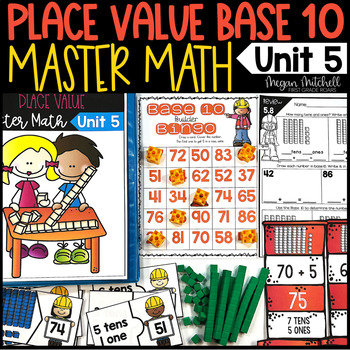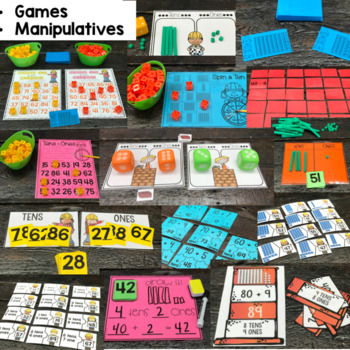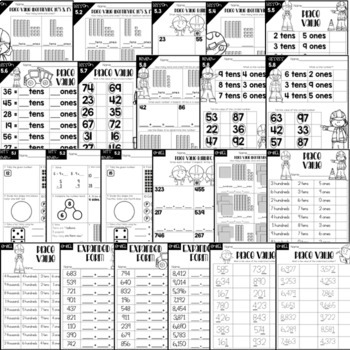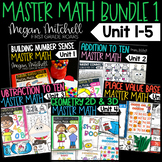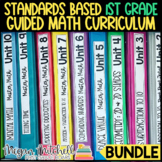Place Value Master Math Unit 5 Base Ten
- Zip
What educators are saying
Also included in
- This bundle contains my first five units of Master Math Curriculum for First Grade. The units included are Unit 1 Number Sense, Unit 2 Addition to 10, Unit 3 Subtraction to 10, Unit 4 Geometry, and Unit 5 Place Value. Everything you would need to teach Math is provided in these units. It is hands onPrice $70.00Original Price $86.00Save $16.00
- This bundle consists of 15 units that I use for my first grade guided math curriculum. It is built around the belief that students need to be exposed to math in a variety of ways. Master Math can be taught in many ways but I will provide the tools to make it a rotation based learning process. EachPrice $200.00Original Price $254.00Save $54.00
Description
This unit is the fifth unit of a first grade MASTER math curriculum built around the belief that students need to be exposed to math in a variety of ways. It focuses on Place Value using base-10 blocks. Students will learn to build numbers using base-10 blocks, identify numbers in base-10, understand place value, find the value of a number, and write numbers up to 99 in expanded form. There are enrichment opportunities to build their number sense to the hundreds and thousands place value. Master Math can be taught in many ways but I will provide the tools to make it a rotation based learning process. Each lesson begins with a whole group mini lesson provided in a SMART notebook version or a pdf file. Then students begin to rotate (much like centers). MASTER stands for Manipulatives, Apply Skills, Small Group, Technology, Enrichment, and Review. There are activities provided for each component listed, lesson plans, assessments, SMART notebook files, and a fun culminating craft. Included you will receive:
Manipulatives
- Base 10 puzzles (4 pieces)
- Tens and Ones Sort
- Build a Number Dry/Erase Mats
- Build a Number Tens/Ones Mat
- Construction Cones Puzzle Mats
- Base 10 Matching Puzzles (number to longs and cubes)
- Base 10 Matching Puzzles (words to the number)
Apply Skills
- Spin a ten or a ones place
- Spin a ten
- Base-10 Bingo
- Base-10 War
- Expanded Form Concentration
- Roll to 100
- Build a Brick House
Small Group
- Counting tens and ones (2)
- Expanded form and tens and ones (2)
- Building a number and expanded form (2)
- Identifying the number in base 10 (3)
- Identifying the number with words (2)
- Identifying the tens and ones in a number(2)
- Identifying the value of a number (2)
- Review of all skills (2 pages)
- Assessment of all skills (2 pages)
- Assessment Extensions (2 pages)
- Answer Keys Provided in this section only
Technology 6 activities in Boom Learning and Google Slides
- Build a Number using longs and cubes
- Identify the value of an underlined number
- Write a number in expanded form
- Identify the tens and ones
- Write the number using tens and ones in words
- Counting base-10 blocks and writing the number
Enrichment
- Building numbers in base-10 to the hundreds place value and expanded form (2)
- How many 100’s, 10’s, & 1’s and expanded form(2)
- Finding the number with 100’s, 10’s, & 1’s provided (2)
- Finding the number with 1000’s, 100’s, 10’s, & 1’s provided (2)
- Expanded form with 100’s, 10’s, & 1’s (2)
- Expanded form with 1000’s, 100’s, 10’s, & 1’s (2)
- Finding the value of the underlined number up to the 100’s place value (2)
- Finding the value of the underlined number up to the 1000’s place value (2)
Review
- Number bonds
- Addition to 10
- Subtraction to 10
- Fact Families
- Number Patterns
- Number Stories
- Shapes
- Halves and Fourths
- Place Value
- Counting Pennies
Construction Kids Craft
Construction Craft cumulative project to review place value
Recording Sheets
Class progress sheet
Individualprogress sheet
Lesson Plans
- 9 lessons completed for you
- 5 templates to create your own
SMART Notebook warm up lessons whole group
- 8 different lessons
- 8 pdf’s in case you don’t have SMART Notebook
Description, I Can Statements, Standards, Binder Cover and Layout
Rotation Templates in SMART Notebook or PDF version
**IMPORTANT NOTES FOR THE TECHNOLOGY PIECES**
Some of this resource is in Google Slides format. You will NEED TO HAVE ACCESS to GOOGLE SLIDES to use this resource. It is also helpful to have GOOGLE CLASSROOM but not necessary. It will help you easily send the activities to your students.
Please note: I am not affiliated or associated with Google, nor do they endorse this resource.
Important: To redeem your Boom Cards, you will create an account for Boom Learning. The account you get with your purchase allows you to play the Boom Cards on interactive whiteboards and with individual students using Fast Play. Fast Play does not save student progress reports.
To use Boom Cards, you must be connected to the Internet. Boom Cards play on modern browsers (Chrome, Safari, Firefox, and Edge). Apps are available for Android, iPads, iPhones, and Kindle Fires. For security and privacy, adults must have a Boom Learning account to use and assign Boom Cards. You will be able to assign the Boom Cards you are buying with "Fast Pins," (play provides instant feedback for self-grading Boom Cards). Fast Play is always a free way for students to engage with Boom Cards decks. For additional assignment options you'll need a premium account. If you are new to Boom Learning, you will be offered a free trial of our premium account. Read here for details: http://bit.ly/BoomTrial.
***To try them out below with this preview link!****
What's my Number in tens and ones
Expanded Form
Similar Units
Number Sense Master Math Unit 1
Addition to 10 Master Math Unit 2
Subtraction to 10 Master Math Unit 3
Place Value Master Math Unit 5
First Grade Math Curriculum Master Math Bundle Units 1-5
Comparing Numbers Master Math Unit 6
Addition and Subtraction to 20 Master Math Unit 7
Applying Properties of Addition and Subtraction to 20 Master Math Unit 8
Telling Time Master Math Unit 9
Mental Math Master Math Unit 10
First Grade Master Math Curriculum Master Math Bundle 6-10
Measurement Master Math Unit 11
Make sure to Follow Me so you know when I post new products. All products are 20% off the 1st 24 hours. You don't want to miss out!
If you would like to join me live to discuss these ideas and more in my classroom, please join my private group.
JOIN MY GROUP ~ FIRST GRADE ROARS ~ CONNECT & COLLABORATE ON FACEBOOK.
Some other fun ways to connect....

